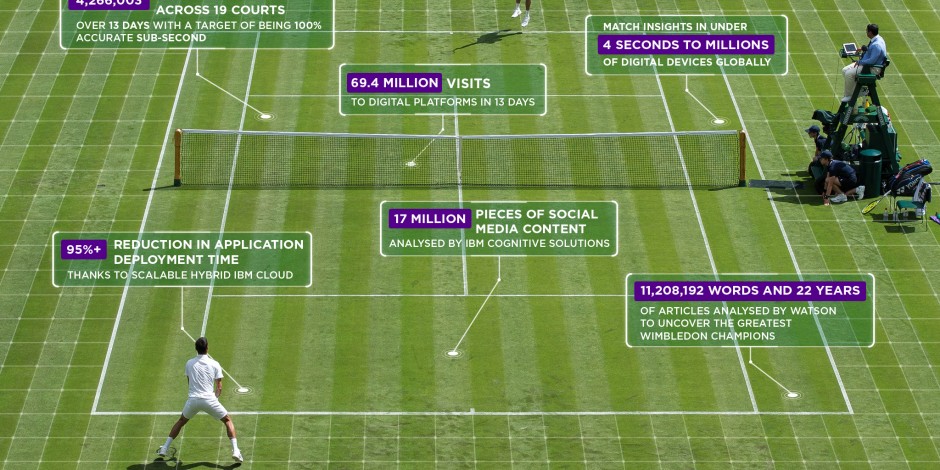AI and the Future of Business Machine learning, task automation and robotics are already widely used in business. These and other AI technologies are about to multiply, and we look at how organizations can best take advantage of them.
copyright by www.zdnet.com
 While spectators eat strawberries and players hit shots, a dedicated team of IT professionals work behind the scenes at Wimbledon to ensure the technology that underlies the world-famous tennis tournament is a cross-court winner.
While spectators eat strawberries and players hit shots, a dedicated team of IT professionals work behind the scenes at Wimbledon to ensure the technology that underlies the world-famous tennis tournament is a cross-court winner.
Simon Boyden, chief architect for IBM at Wimbledon, took ZDNet on a behind-the-scenes ‘bunker tour’ of the technology in play during The Championships. Housed in Wimbledon’s media centre, the bunker is home for two weeks to a group of IBM data and infrastructure specialists who deliver IT operations and digital platforms.
In the operations room professionals monitor banks of screens to confirm systems are running effectively. “Generally, the work that takes place in here is all about data,” says Boyden. “The core of our operation is statistics.”
The operations centre receives a constant drip feed of data from 48 up-and-coming tennis players who sit court-side and record details from matches, such as serves, returns and points in a rally. IBM uses club-standard players to record data as they understand subtle nuances in the game, such as the difference between a forced and unforced error.
This electronic system helps IBM capture about four and a half million data points during the two-week tournament. In total, the firm now holds about 50 million data points within its tournament database. “That information is the heart of our activity and feeds what we call the Wimbledon Information System (WIS),” says Boyden.
“A lot of the data that we take gets fed through to the broadcasters and they need stats straightaway. There’s about 3,500 accredited members of the press on site. And we also provide video of all the points that have played 30 minutes after the match, to both the media and the players, through a dedicated portal.”
Boyden demonstrates how media professionals and tennis players can dip into the system and trace historical data back to the 1870s. A supporting data-science team provides reactive answers to press questions. The team also works proactively, searching the system for facts that can enliven commentators’ delivery.
Thank you for reading this post, don't forget to subscribe to our AI NAVIGATOR!
IBM also feeds data to SlamTracker, an analytics technology that draws detailed information from WIS and provides in-match statistics in a consumer-friendly way to spectators. SlamTracker is housed on the Wimbledon website and provides a graphical representation of the match, suggesting how it has evolved and what the result might be. […]
read more – copyright by www.zdnet.com


AI and the Future of Business Machine learning, task automation and robotics are already widely used in business. These and other AI technologies are about to multiply, and we look at how organizations can best take advantage of them.
copyright by www.zdnet.com
Simon Boyden, chief architect for IBM at Wimbledon, took ZDNet on a behind-the-scenes ‘bunker tour’ of the technology in play during The Championships. Housed in Wimbledon’s media centre, the bunker is home for two weeks to a group of IBM data and infrastructure specialists who deliver IT operations and digital platforms.
In the operations room professionals monitor banks of screens to confirm systems are running effectively. “Generally, the work that takes place in here is all about data,” says Boyden. “The core of our operation is statistics.”
The operations centre receives a constant drip feed of data from 48 up-and-coming tennis players who sit court-side and record details from matches, such as serves, returns and points in a rally. IBM uses club-standard players to record data as they understand subtle nuances in the game, such as the difference between a forced and unforced error.
This electronic system helps IBM capture about four and a half million data points during the two-week tournament. In total, the firm now holds about 50 million data points within its tournament database. “That information is the heart of our activity and feeds what we call the Wimbledon Information System (WIS),” says Boyden.
“A lot of the data that we take gets fed through to the broadcasters and they need stats straightaway. There’s about 3,500 accredited members of the press on site. And we also provide video of all the points that have played 30 minutes after the match, to both the media and the players, through a dedicated portal.”
Boyden demonstrates how media professionals and tennis players can dip into the system and trace historical data back to the 1870s. A supporting data-science team provides reactive answers to press questions. The team also works proactively, searching the system for facts that can enliven commentators’ delivery.
Thank you for reading this post, don't forget to subscribe to our AI NAVIGATOR!
IBM also feeds data to SlamTracker, an analytics technology that draws detailed information from WIS and provides in-match statistics in a consumer-friendly way to spectators. SlamTracker is housed on the Wimbledon website and provides a graphical representation of the match, suggesting how it has evolved and what the result might be. […]
read more – copyright by www.zdnet.com
Share this: